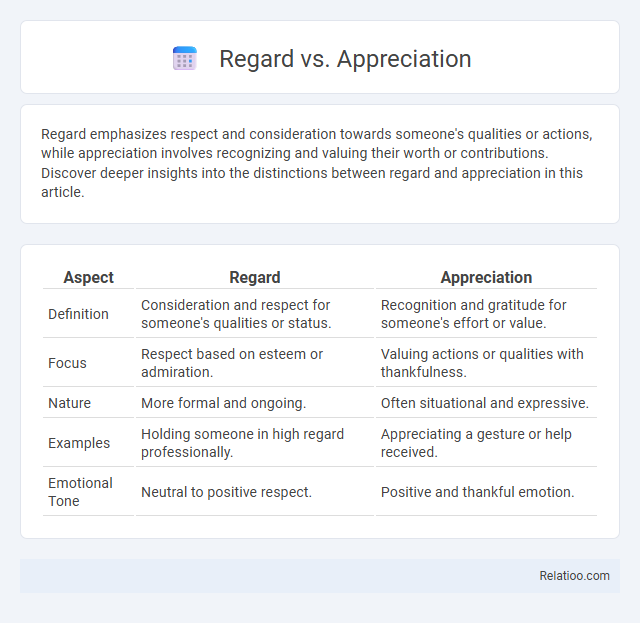Regard emphasizes respect and consideration towards someone's qualities or actions, while appreciation involves recognizing and valuing their worth or contributions. Discover deeper insights into the distinctions between regard and appreciation in this article.
Table of Comparison
| Aspect | Regard | Appreciation |
|---|---|---|
| Definition | Consideration and respect for someone's qualities or status. | Recognition and gratitude for someone's effort or value. |
| Focus | Respect based on esteem or admiration. | Valuing actions or qualities with thankfulness. |
| Nature | More formal and ongoing. | Often situational and expressive. |
| Examples | Holding someone in high regard professionally. | Appreciating a gesture or help received. |
| Emotional Tone | Neutral to positive respect. | Positive and thankful emotion. |
Understanding Regard and Appreciation
Understanding regard involves recognizing the esteem or respect one holds for a person, object, or concept, emphasizing a thoughtful awareness of value. Appreciation goes deeper, reflecting gratitude and a positive evaluation of qualities or actions, often accompanied by emotional warmth. While regard can be neutral or formal, appreciation inherently conveys a sense of thankfulness and acknowledgment of worth.
Defining Regard: Meaning and Usage
Regard refers to the act of considering someone or something with a particular feeling or respect, often implying attention or esteem. It is commonly used to express how one views or values an individual, object, or idea in various contexts, such as social interactions or professional settings. Understanding regard involves recognizing its role in conveying acknowledgment and the degree of value placed on the subject.
Defining Appreciation: Meaning and Usage
Appreciation refers to the recognition and enjoyment of the good qualities of someone or something, emphasizing gratitude and valuing contributions or efforts. It is often expressed through words or actions that acknowledge kindness, achievements, or positive traits, fostering positive relationships and motivation. Unlike regard, which implies respect or consideration, appreciation highlights an active acknowledgment and emotional response to value.
Key Differences Between Regard and Appreciation
Regard emphasizes a general feeling of respect or consideration toward someone or something based on their qualities or status. Appreciation involves a deeper recognition and gratitude for specific actions, efforts, or attributes, highlighting value and acknowledgment beyond mere respect. Your understanding of key differences lies in seeing regard as respectful acknowledgment whereas appreciation conveys heartfelt recognition and thankfulness.
The Role of Regard in Relationships
Regard in relationships signifies a deep level of respect and consideration that fosters trust and emotional connection between individuals. Unlike appreciation, which often centers on recognizing specific actions or qualities, regard encompasses a broader, ongoing attitude of valuing someone's presence and well-being. Your ability to hold others in genuine regard builds a foundation for meaningful and lasting interpersonal bonds.
The Role of Appreciation in Personal Growth
Appreciation plays a crucial role in personal growth by fostering self-awareness and emotional intelligence, which enhances your ability to recognize and value both your achievements and the efforts of others. While regard represents respect or esteem often based on reputation, appreciation goes deeper by acknowledging intrinsic worth and promoting positive reinforcement. Cultivating appreciation nurtures meaningful relationships and motivates continuous development by encouraging gratitude and mindfulness.
Cultural Perspectives on Regard vs. Appreciation
Cultural perspectives significantly influence how regard and appreciation are expressed and perceived, with some societies emphasizing formal respect (regard) while others prioritize heartfelt acknowledgment (appreciation). In collectivist cultures, showing regard often involves customs and rituals that reinforce social harmony, whereas appreciation is communicated through personal gestures reflecting emotional connection. Understanding these nuances helps you navigate cross-cultural interactions more effectively, ensuring your expressions of regard or appreciation resonate appropriately.
Expressions of Regard in Everyday Life
Expressions of regard in everyday life convey respect, admiration, and acknowledgment towards others, often through gestures like polite language, thoughtful actions, and attentive listening. Appreciation deepens this interaction by specifically recognizing someone's efforts or qualities, frequently expressed through gratitude, compliments, or rewards. Both terms overlap in showing positive social attitudes, yet regard emphasizes general respect while appreciation targets valuing particular contributions or traits.
Ways to Show Appreciation Effectively
Showing appreciation effectively involves personalized gestures such as sincere verbal acknowledgments, handwritten thank-you notes, and meaningful gifts that reflect the recipient's preferences. Acts of kindness, public recognition, and consistent supportive actions further deepen feelings of gratitude and reinforce positive relationships. Prioritizing timely and genuine expressions of appreciation enhances emotional connections and fosters mutual respect in both personal and professional environments.
Importance of Balancing Regard and Appreciation
Balancing regard and appreciation is essential for fostering positive relationships and maintaining mutual respect in both personal and professional settings. High regard establishes trust and recognition of someone's intrinsic value, while appreciation emphasizes gratitude for specific actions or qualities, promoting motivation and engagement. Prioritizing both creates a harmonious dynamic where individuals feel valued and encouraged, leading to enhanced collaboration and overall satisfaction.

Infographic: Regard vs Appreciation
 relatioo.com
relatioo.com